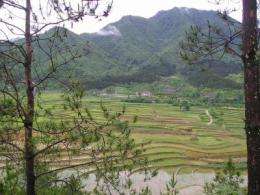Making sustainability policies sustainable

Sweeping environmental policies come with hidden challenges – not only striving to achieve sustainability and benefit the environment – but over time ensuring the program itself can endure.
Scientists at Michigan State University and their colleagues in China are examining China's massive Grain to Green Program (GTGP) – an effort to persuade farmers to return cropland to forest through financial incentives. Their results were reported in this week's journal Ecological Indicators.
The goal – developing a unique targeted approach that applies the combination of environmental sciences and social sciences to get a full picture of how policy really is working, and how it can grow stronger. It's important not only to offer insight to China as it continues to shape it's Grain to Green Program, but also across the world as governments strive to protect their environment while enabling people to thrive.
By some measurements, the GTGP has been enormously successful as it is vast. In its 12 years it has invested more than 200 billion yuan (about $32 billion U.S.) to persuade more than 120 million farmers in 32 million households to return 8.8 million hectares of cropland to forest and grassland.

The question addressed by Andrés Viña, assistant professor of fisheries and wildlife, Jianguo "Jack" Liu, director of MSU's Center for Systems Integration and Sustainability (CSIS) and their collaborators is: is it the right land being enrolled in the program, and will farmers remain committed to the program, or will they eventually decide they're better off farming?
Farmers in the study area of southwestern China are famous for their persistence in turning seemingly any land—no matter how steep or remote – into farmland. This has threatened valuable ecosystems in a land rich in biodiversity and home to endangered species, most notably the giant pandas. More cropland not only means less forests but also less bamboo – the sole item on the panda's menu. It also can mean fragmenting precious habitat.
GTGP aims to give farmers an incentive to put away their plows and hoes by providing cash, grain and tree seedlings. The program is intended to target land not best suited for farming – most notably land that is on steep hillsides and close to existing forests. As the article notes, the program's success depends not only on ecosystem services provided by the land enrolled in the program, but also on the willingness of local people to forgo their land use activities.
The researchers worked to identify land that would provide the highest environmental benefits when returned to forest, while presenting the least chance for farmers to return it back to cropland. That second piece has been particularly elusive, yet Viña said that is key for sustaining the environmental benefits obtained by the program. So the team collected data on slope, to evaluate soil erosion and landside susceptibility; the likelihood a land parcel would be farmed, and the probability a farmer would want to enroll – and stay enrolled – in the program.
"While these measures don't give a complete picture of all the environmental benefits of such a program, their combination through our targeting approach enhances the chance of obtaining higher benefits under the same budget," Viña said. "This could, therefore, improve the overall efficiency of the program."
The results indicated there is room for improvement as right now too much land enrolled in the program is located in flat areas. They also found that policymakers would do well communicating more with farmers to better understand their wants and needs.
"Some farmers have complained that the payment received does not fully compensate their forgone economic returns from cropping the land enrolled in the program. Therefore, they are more likely to return it to cropland, undermining the success of the program." Viña said.
Provided by Michigan State University















